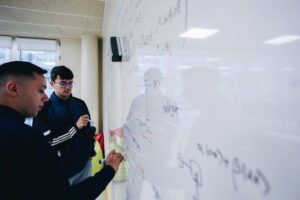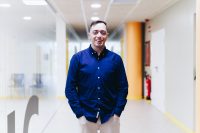CiTIUS develops protocols and a new programming language to make it easier for quantum and classical computers to work together
As long as quantum computers remain small, they have to operate jointly through distributed systems to deliver good results. What seems clear is that working alone or in groups, they will coexist in the long term with classical computers in a sort of symbiosis. This hybrid and distributed model needs tools to extract their full potential in a way that is efficient and accessible to programmers. CiTIUS is contributing to this challenge by developing protocols for connecting devices and an intermediate programming language
When he was only 24 years old, Ferdinand Porsche created what is considered the first hybrid car in history, powered by an octagonal electric motor. The Lhoner-Porsche Electromobile was a sensation at the Paris Exhibition and, although its commercial production was shelved for nearly a century due to excessive weight and lack of autonomy, it laid the foundations for what today is the great promise of clean mobility. In 1997, the Japanese automotive industry revived Porsche’s idea by launching the Toyota Prius. By the end of the 20th century, technology had advanced enough to offer a hybrid model to the mass market, but not sufficiently to develop an all-electric vehicle.

Francisco Javier
Cardama
The transition to fossil fuel-free mobility is an example of how disruptive technologies sometimes need to be initially integrated with their predecessors until the conditions are developed for them to take over.
This hybrid model is already allowing to draw upon some quantum advantages in the field of computing, although, according to experts, quantum computing is not expected to replace classical computing, at least in the near future. There is a consensus that there will be a long-term coexistence and that is why it is necessary to develop the best possible formulas to take advantage of the classical-quantum computing binomial.
Hybrid and distributed systems
As long as quantum computers remain small and noisy –a term that refers to the fact that they are error-prone– in addition to integrating them into hybrid systems, it is necessary to connect them in a network –in what is called a distributed system– to obtain sufficient computing capacity. This is the field of research to which the project Javi Cardama, working on at the Centro Superior de Investigación en Tecnologías Inteligentes de la Universidade de Santiago de Compostela (CITiUS), wishes to contribute.
“Although the term quantum sounds appealing, these computers do not outperform classical computers in everything. However, there are specific tasks where they are more efficient and may even solve problems that classical ones cannot tackle,” Cardama explains. “The goal is to leverage the strengths of each type of computing in the tasks where they are most efficient.”.
Collaboration between classical and quantum computers can be very useful in training machine learning models –such as ChatGPT–, cryptography, molecular simulation –with application in biotechnology and pharmacology–, and optimization of complex problems –such as urban planning or air traffic management–. These are just a few examples, but they are relevant enough to justify a research and technological effort such as the one being developed at CiTIUS.
“Connecting heterogeneous devices efficiently is not an easy task. Tools must be developed that allow programmers to execute tasks on each compute node in a simple way while exploiting the particular characteristics of each computing model,” says Cardama.
His work seeks to extend the tools that have already been developed for programming –as is the case with graphics cards– with the aim to include quantum computers in the computing ecosystem. “This will allow developers to interact with different types of hardware, including quantum devices, in a unified and efficient way,” the researcher highlights.
 For classical and quantum computers to work together, they need to communicate efficiently. The approach being used by the CiTIUS project is to use classical communication only to launch quantum programs. “This means that the classical computer starts the process but, once the quantum program begins to run, all the quantum processing is carried out autonomously, without classical interference until the result is ready,” Cardama says, illustrating that this type of approach seeks to maximize efficiency and minimize interruptions.
For classical and quantum computers to work together, they need to communicate efficiently. The approach being used by the CiTIUS project is to use classical communication only to launch quantum programs. “This means that the classical computer starts the process but, once the quantum program begins to run, all the quantum processing is carried out autonomously, without classical interference until the result is ready,” Cardama says, illustrating that this type of approach seeks to maximize efficiency and minimize interruptions.
Este trabajo conjunto entre computadores clásicos y cuánticos implica que estos últimos sean varios y estén conectados en red. This joint work between classical and quantum computers implies that the latter are several and networked. “Currently, we are not able to build devices with a large number of qubits. That is why it is crucial to be able to connect several quantum computers to solve large-scale problems,” the researcher explains. In other words, in order for quantum computers to contribute their acceleration power to classical computers, for the time being, they have to do so in a group, while waiting for a quantum computer to be developed that may be powerful enough to collaborate autonomously with a classical computer.
With regard to the protocols for this distributed model, they are working on the definition of an intermediate programming language for distributed quantum processors. “In a nutshell, what we are looking for with this language is to establish a common language that allows different quantum devices to understand each other, regardless of any differences in their architecture,” explains Cardama.
This language they are developing is called NetQIR (Net Quantum Intermediate Representation) and they expect it to facilitate the development of new tools. For now, they have a beta version, with the challenge of making it simple to handle and translatable to the specific instructions used by quantum computers. “The next steps include integrating this intermediate language into heterogeneous programming tools that are already widely used by classical programmers. This approach aims to ease the transition to quantum computing and make it possible for developers to incorporate this technology more naturally into environments with which they are already familiar,” says the CiTIUS researcher.
Short-term and long-term vision
This project, framed within the Complementary Quantum Communication Plan (PCCC), counts on the collaboration of the Galicia Supercomputing Center (CESGA) to make a relevant contribution to the advancement of the technology. “We wish to be ready for when quantum computing reaches an adequate level of efficiency,” asserts Cardama. “The goal is that, when this happens, our tools and languages will be sufficiently developed to facilitate a smooth transition and allow programmers to take advantage of the potential of quantum computing without facing major technical or learning barriers,” he states, referring to the fact that right now, there is not enough level of abstraction in the language to program without having a deep knowledge of the physical operation of quantum processors.
In the short term, the project aims to reduce the learning curve for using quantum computing, making the technology more accessible to programmers who lack in-depth knowledge of quantum mechanics.
In the long term, the CiTIUS team foresees that these tools will facilitate the incorporation of quantum computing in sectors where they can offer clear advantages, such as the optimization of industrial processes or the simulation of complex physical systems.
El futuro cuántico
Javi Cardama assures that it is complicated to predict the future in a field where there are still many limitations that cannot be solved with the materials and technologies available. “Even so, I believe that in the next five years, we will be able to have a standard software infrastructure to program today’s quantum computers and be prepared for future ones. This standardization will reduce the complexity of quantum development, allowing researchers to concentrate on innovating and optimizing algorithms, without having to worry so much about the technical peculiarities of the underlying hardware.”
This scenario of technological advancement should, in the CiTIUS researcher’s opinion, be different from that of classical computing, whose development was largely driven by private industries. “I believe that in the case of quantum computing, this ought to change. The development of a sufficiently powerful quantum computer poses a security problem, as it could breach current cryptographic systems, a catastrophic situation if it were to fall into the wrong hands. This is why I consider it crucial for public institutions to take an active role and invest in these technologies. It is an opportunity for governments to ensure that the benefits of quantum computing are distributed equitably and not concentrated in private hands for purely commercial purposes.”
Along the same lines, Cardama points to another problem that should be addressed in this area of research: the difficulty in retaining talent. “The profile of a person with knowledge in quantum computing requires extensive training in mathematics, physics and computer science, which means that such kind of researchers are very scarce and, on many occasions, end up going working for the private sector, which offers better conditions than the university environment,” he says, calling for the precariousness of research in the public ecosystem to be resolved.
Contact: javier.cardama@usc.es
Web: https://citius.gal/team/francisco-javier-cardama-santiago/
Publications:
Barral, D., Cardama, F.J., Díaz, G., Faílde, D., Llovo, I.F., Mussa Juane, M., Vázquez-Pérez, J., Villasuso, J., Piñeiro, C., Costas, N., Pichel, J. C., Pena, T. F., Gómez, A. (2024) Review of Distributed Quantum Computing. From single QPU to High Performance Quantum Computing. https://arxiv.org/pdf/2404.01265
Vázquez-Pérez, J., Cardama, F. J., Piñeiro, C., Pena, T. F., Pichel, J. C., Gómez, A. (2024) NetQIR: An Extension of QIR for Distributed Quantum Computing. https://arxiv.org/pdf/2408.03712
Vázquez-Pérez, J., Piñeiro, C., Pichel, J.C. et al. QPU integration in OpenCL for heterogeneous programming. J Supercomput 80, 11682–11703 (2024). https://link.springer.com/article/10.1007/s11227-023-05879-9






